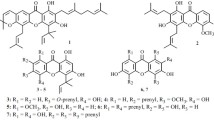Abstract
The CHCl3 fraction of Cnidium monnieri fruits significantly inhibited the proliferation of hepatic stellate cells in an in-vitro assay system employing HSC-T6 hepatic stellate cell lines. Activity-guided fractionation of the CHCl3 fraction of C. monnieri led to the isolation of ten coumarins: osthol (1), meranzin (2), auraptenol (3), meranzin hydrate (4), 7-hydroxy-8-methoxy coumarin (5), imperatorin (6), xanthotoxol (7), xanthotoxin (8), bergapten (9) and isopimpinellin (10). Of these, compounds 1 and 6 significantly inhibited proliferation of HSCs in a time- and concentration-dependent manner. In addition, compounds 1 and 6 significantly reduced collagen content in HSC-T6 cells.





Similar content being viewed by others
References
Li D, Friedman SL (1999) Liver fibrogenesis and the role of hepatic stellate cells: new insights and prospects for therapy. J Gastroenterol Hepatol 14:618–633
Tsukada S, Parsons CJ, Rippe RA (2006) Mechanisms of liver fibrosis. Clin Chim Acta 364:33–60
Bataller R, Brenner DA (2005) Liver fibrosis. J Clin Invest 115:209–218
Wu J, Zern MA (2000) Hepatic stellate cells: a target for the treatment of liver fibrosis. J Gastroenterol 35:665–672
Lee MK, Yang H, Yoon JS, Jeong EJ, Kim DY, Ha NR, Sung SH, Kim YC (2008) Antifibrotic activity of diterpenes from Biota orientalis leaves on hepatic stellate cells. Arch Pharm Res 31:866–871
Uyama N, Shimahara Y, Okuyama H, Kawada N, Kamo S, Ikeda K, Yamaoka Y (2003) Carbenoxolone inhibits DNA synthesis and collagen gene expression in rat hepatic stellate cells in culture. J Hepatol 39:745–799
Lee MK, Ha NR, Yang H, Sung SH, Kim GH, Kim YC (2008) Antiproliferative activity of triterpenoids from Eclipta prostrata on hepatic stellate cells. Phytomedicine 15:775–780
Sakata R, Ueno T, Nakamura T, Sakamoto M, Torimura T, Sata M (2004) Green tea polyphenol epigallocatechin-3-gallate inhibits platelet-derived growth factor-induced proliferation of human hepatic stellate cell line LI90. J Hepatol 40:52–59
Zhu YP (1999) Chinese material medica, chemistry, pharmacology and application. Harwood Academic Publishers, Amsterdam, pp 624–625
Zhang Q, Qin L, He W, Van Puyvelde L, Maes D, Adams A, Zheng H, De Kimpe N (2007) Coumarins from Cnidium monnieri and their antiosteoporotic activity. Planta Med 73:13–19
Chou SY, Hsu CS, Wang KT, Wang MC, Wang CC (2007) Antitumor effects of osthol from Cnidium monnieri: an in vitro and in vivo study. Phytother Res 21:226–230
Ito C, Furukawa H (1987) Constituents of Murraya exotica L. Structure elucidation of new coumarins. Chem Pharm Bull 35:4277–4285
Feger W, Brandauer H, Gabris P, Ziegler H (2006) Nonvolatiles of commercial lime and grapefruit oils separated by high-speed countercurrent chromatography. J Agric Food Chem 54:2242–2252
Imai F, Kinoshita T, Sankawa U (1989) Constituents of the leaves of Murraya paniculata collected in Taiwan. Chem Pharm Bull 37:358–362
Kim JS, Kim JC, Shim SH, Lee EJ, Jin WY, Bae KH, Son KH, Kim HP, Sang SS, Chang HW (2006) Chemical constituents of the root of Dystaenia takeshimana and their anti-inflammatory activity. Arch Pharm Res 29:617–623
Cai JN, Basnet P, Wang ZT, Komatsu K, Xu LS, Tani T (2000) Coumarins from the fruits of Cnidium monnieri. J Nat Prod 63:485–488
Hitotsuyanagi Y, Kohima H, Ikuta H, Takeya K, Itokawa H (1996) Identification and structure–activity relationship studies of osthol, a cytotoxic principle from Cnidium monnieri. Bioorg Med Chem Lett 15:1791–1794
Acknowledgments
We thank Prof. S.L. Freidman (Columbia University, New York) for the kindly gift of the HSC-T6 cells. This work was supported by the Medical Research Center Program (2010-0029480), the Regional Core Research Program (Chungbuk BIT Research-Oriented University Consortium) and Basic Science Research Program (2010-0025054) through the National Research Foundation of Korea (NRF).
Author information
Authors and Affiliations
Corresponding author
Rights and permissions
About this article
Cite this article
Shin, E., Lee, C., Sung, S.H. et al. Antifibrotic activity of coumarins from Cnidium monnieri fruits in HSC-T6 hepatic stellate cells. J Nat Med 65, 370–374 (2011). https://doi.org/10.1007/s11418-010-0485-7
Received:
Accepted:
Published:
Issue Date:
DOI: https://doi.org/10.1007/s11418-010-0485-7




